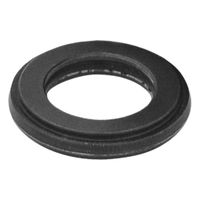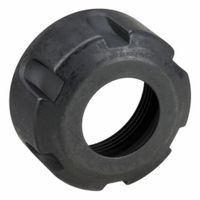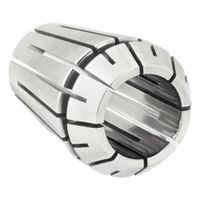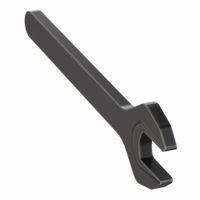Call +(254) 703 030 000 / 751 483 999 / 721 704 777
- Home
- Machining
- Toolholding Tooling Systems
- Collets Accessories
.....Read More
Frequently Asked Questions
What is a collet and how does it work?
A collet is a type of chuck that forms a collar around an object to be held and exerts a strong clamping force on the object when it is tightened. It is typically used to hold a tool or a workpiece in place during machining operations. Collets are commonly used in lathes, milling machines, and other precision machining equipment.
The collet is usually a cylindrical sleeve made of spring steel, which is slotted along its length to allow it to expand and contract. It is designed to fit over the object to be held, such as a drill bit or a workpiece, and is then inserted into a tapered socket in the machine. When the collet is tightened, typically by a drawbar or a nut, the tapered socket forces the collet to contract, gripping the object securely.
Collets are preferred for their ability to provide a high level of precision and concentricity, as they grip the object evenly around its circumference. This minimizes runout and ensures that the tool or workpiece is held securely and accurately in place. Collets are available in various sizes and types, including ER collets, R8 collets, and 5C collets, each designed for specific applications and machines.
In summary, a collet is a precision tool-holding device that works by contracting around an object to hold it securely in place, providing high accuracy and stability in machining operations.
How do I choose the right collet size for my tool?
To choose the right collet size for your tool, follow these steps:
1. **Identify the Tool Shank Size**: Determine the diameter of the tool shank you intend to use. This is the most critical factor, as the collet must match the tool shank size precisely for a secure fit.
2. **Check Collet Specifications**: Review the specifications of the collet system you are using. Collets are typically available in standard sizes, such as ER collets (e.g., ER11, ER16, ER20), which indicate the range of shank sizes they can accommodate.
3. **Match the Collet to the Tool Shank**: Select a collet that matches the tool shank size. For example, if you have a 6mm tool shank, choose a collet that can securely hold a 6mm diameter.
4. **Consider the Collet System**: Ensure compatibility with your tool holder or spindle. Different machines and tool holders may require specific collet systems, so verify that the collet fits your equipment.
5. **Check for Tolerance and Precision**: Ensure the collet provides the necessary tolerance and precision for your application. High-precision collets are essential for applications requiring tight tolerances.
6. **Inspect for Wear and Damage**: Regularly inspect collets for wear or damage. A worn or damaged collet can lead to tool slippage or poor performance.
7. **Consult Manufacturer Guidelines**: Refer to the tool and collet manufacturer’s guidelines for recommendations on collet size and compatibility.
8. **Consider Future Needs**: If you anticipate using a range of tool sizes, consider a collet set that covers a variety of sizes within your expected range.
By following these steps, you can ensure that you select the appropriate collet size for your tool, ensuring optimal performance and safety.
What are the differences between ER collets and other types?
ER collets are a type of tool holder used in machining to secure cutting tools. They are known for their versatility and precision. Here are the key differences between ER collets and other types of collets:
1. **Design and Versatility**: ER collets have a unique design with a wide clamping range, allowing them to hold various tool sizes with a single collet. This contrasts with other collets like 5C or R8, which have a more limited clamping range and often require a specific collet for each tool size.
2. **Clamping Range**: ER collets can typically compress by 1mm (or 0.039 inches), providing a broader clamping range compared to other collets. This makes them more adaptable to different tool sizes without needing to change the collet.
3. **Precision and Concentricity**: ER collets are known for their high precision and excellent concentricity, often achieving runout tolerances of less than 0.0005 inches. This is generally superior to other collet types, making ER collets ideal for high-precision machining tasks.
4. **Locking Mechanism**: ER collets use a locking nut to secure the collet in place, which provides a strong and reliable grip on the tool. Other collet types, like 5C, may use a drawbar or other mechanisms, which can be less secure or more cumbersome to use.
5. **Applications**: ER collets are widely used in CNC machining and milling due to their versatility and precision. In contrast, other collets like 5C are often used in manual lathes and for workholding applications.
6. **Availability and Cost**: ER collets are widely available and come in various sizes, making them a popular choice in many machining environments. They can be more cost-effective in the long run due to their versatility, despite potentially higher initial costs compared to some other collet types.
How do I properly maintain and clean collets?
To properly maintain and clean collets, follow these steps:
1. **Regular Inspection**: Frequently inspect collets for wear, damage, or debris. Look for signs of rust, cracks, or deformation.
2. **Cleaning**: After each use, clean the collets thoroughly. Use a soft brush or compressed air to remove chips and debris. Avoid using metal brushes that can scratch the surface.
3. **Degreasing**: Periodically degrease collets using a suitable solvent. Submerge the collet in the solvent and use a brush to remove any oil or grease buildup. Ensure the solvent is compatible with the collet material.
4. **Drying**: After cleaning, dry the collets completely to prevent rust. Use a clean, lint-free cloth or compressed air to ensure no moisture remains.
5. **Lubrication**: Apply a light coat of machine oil or a rust-preventive spray to protect against corrosion. Ensure the oil is evenly distributed and wipe off any excess.
6. **Storage**: Store collets in a clean, dry environment. Use a collet rack or holder to prevent them from rolling or getting damaged. Avoid stacking collets directly on top of each other.
7. **Handling**: Handle collets with care to avoid dropping or striking them against hard surfaces, which can cause damage.
8. **Usage**: Ensure collets are properly seated and tightened in the chuck to prevent slippage and uneven wear. Avoid over-tightening, which can cause deformation.
9. **Replacement**: Replace collets that show signs of excessive wear, damage, or loss of concentricity to maintain machining accuracy and safety.
By following these steps, you can extend the life of your collets and ensure optimal performance in machining operations.
What are the common issues with collets and how can they be resolved?
Common issues with collets include:
1. **Wear and Tear**: Over time, collets can wear out, leading to poor grip and reduced accuracy. Regular inspection and replacement of worn collets can resolve this issue.
2. **Improper Clamping**: If a collet is not clamping properly, it may be due to dirt or debris. Cleaning the collet and the spindle can improve clamping efficiency.
3. **Incorrect Size**: Using the wrong size collet for the tool or workpiece can cause slippage or damage. Ensuring the correct size collet is used for each application is crucial.
4. **Over-tightening**: Excessive tightening can damage the collet and the tool. Using a torque wrench to apply the correct amount of force can prevent this problem.
5. **Misalignment**: Misalignment between the collet and the spindle can lead to vibration and poor performance. Proper alignment and regular maintenance checks can help avoid this issue.
6. **Corrosion**: Exposure to moisture or corrosive materials can lead to rust and corrosion. Keeping collets dry and applying a protective coating can prevent corrosion.
7. **Fatigue**: Repeated use can cause metal fatigue, leading to failure. Regularly replacing collets based on usage frequency can mitigate this risk.
8. **Inadequate Lubrication**: Lack of lubrication can cause friction and wear. Applying appropriate lubricants can enhance performance and longevity.
9. **Temperature Fluctuations**: Extreme temperatures can affect collet performance. Using collets within their specified temperature range is essential.
10. **Improper Storage**: Storing collets improperly can lead to damage. Using protective cases or racks for storage can prevent this.
By addressing these issues through regular maintenance, proper usage, and timely replacement, collet performance can be optimized, ensuring precision and efficiency in machining operations.
How do I install and remove a collet from a machine spindle?
To install a collet in a machine spindle, first ensure the machine is powered off for safety. Clean the spindle and collet to remove any debris. Insert the collet into the spindle's collet nut, ensuring it clicks into place. Thread the collet nut onto the spindle by hand, then use a wrench to tighten it securely. Insert the tool into the collet, ensuring it is properly seated. Tighten the collet nut further to secure the tool, using a torque wrench if specified by the manufacturer.
To remove a collet, first power off the machine. Use a wrench to loosen the collet nut. If the tool does not release immediately, continue loosening the nut until the collet is free. Remove the tool from the collet. Unscrew the collet nut completely and remove the collet from the spindle. Clean the collet and spindle to ensure they are free of debris before storing or replacing the collet.
What accessories are essential for using collets effectively?
To use collets effectively, several accessories are essential:
1. **Collet Chuck**: This is the primary holder for the collet. It is mounted on the machine spindle and provides the necessary grip and alignment for the collet to hold the tool or workpiece securely.
2. **Collet Nut**: This component secures the collet within the chuck. It is tightened to compress the collet around the tool or workpiece, ensuring a firm grip.
3. **Wrench or Spanner**: Used to tighten or loosen the collet nut. The correct size and type of wrench are crucial to apply the right amount of torque without damaging the components.
4. **Collet Closer**: In some setups, especially in CNC machines, a collet closer is used to automate the opening and closing of the collet, enhancing efficiency and precision.
5. **Collet Rack or Holder**: Organizes and stores collets when not in use. This accessory helps in quickly identifying and accessing the required collet size, maintaining order and preventing damage.
6. **Cleaning Tools**: Brushes or compressed air are used to clean the collet and chuck surfaces. Clean surfaces ensure proper seating and grip, reducing the risk of slippage or misalignment.
7. **Lubricants**: Applied to the threads of the collet nut and chuck to ensure smooth operation and prevent wear.
8. **Dial Indicator**: Used to check the runout of the collet setup, ensuring precision in machining operations.
9. **Collet Stop**: An internal accessory that provides a consistent depth stop for the tool or workpiece, ensuring repeatability in operations.
10. **Protective Gloves**: To handle collets safely, especially when dealing with sharp or hot components.
These accessories collectively ensure the effective and safe use of collets in various machining applications.




